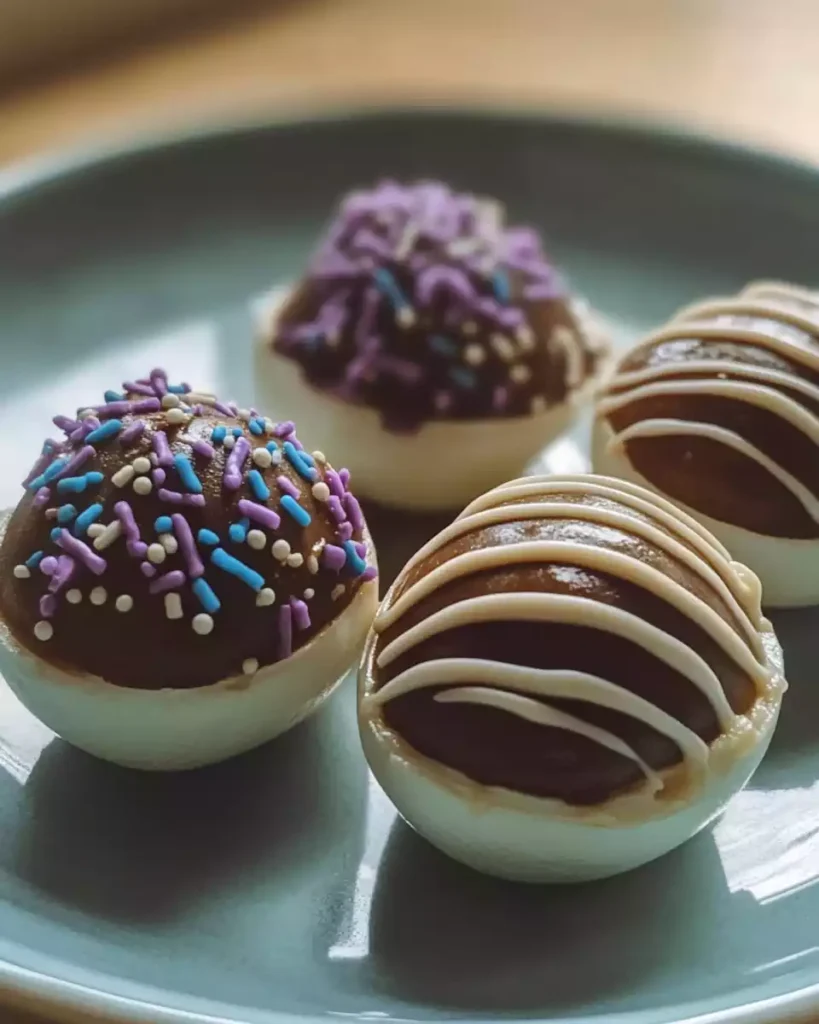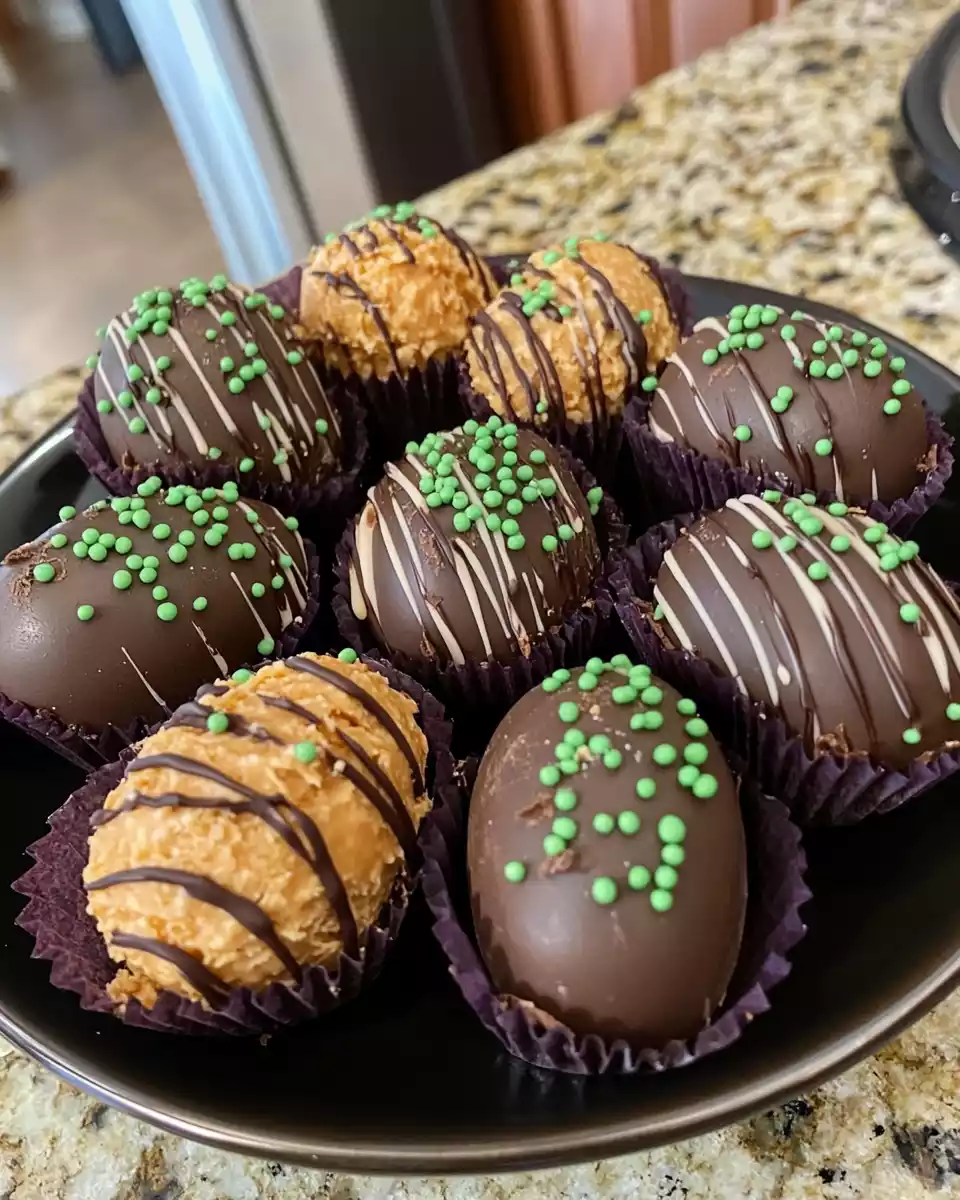Table of Contents
Introduction
Chocolate peanut butter eggs are a delightful confection that combines rich chocolate with a creamy peanut butter filling. Traditionally made during Easter, these treats are popular worldwide for their irresistible taste and smooth texture.
With peanut butter and chocolate being one of the most beloved flavor pairings, it’s no wonder these eggs are a seasonal favorite. Many major brands, such as Reese’s, have capitalized on their popularity, but homemade versions allow for customization and fresher flavors.
The Origins of Chocolate and Peanut Butter
Chocolate comes from the cacao tree (Theobroma cacao), which was first cultivated by ancient civilizations. Over time, technological advancements led to the development of solid chocolate, with the first modern chocolate bar produced in the 19th century.
Peanuts originated in South America, with evidence of their cultivation dating back to around 3,500 years ago.Peanut butter quickly gained popularity, especially in the United States, and became a staple in American households.
The combination of chocolate and peanut butter is a relatively modern creation. This creation became immensely popular, and the chocolate-peanut butter duo is now one of the most iconic flavor pairings in the world.
Today, chocolate and peanut butter are used in countless desserts, from cookies to ice cream, and continue to be a favorite among sweet lovers worldwide.
Step-by-Step Recipe
- In a mixing bowl, combine peanut butter, melted butter, and vanilla extract. Stir until smooth.
- Gradually add powdered sugar, mixing until a dough forms. If the mixture is too sticky, add a little more powdered sugar.
- Shape the peanut butter mixture into small egg shapes and place them on a parchment-lined baking sheet.
- Refrigerate for at least 30 minutes, or until firm.
- In a microwave-safe bowl, melt the chocolate chips with coconut oil in 30-second intervals, stirring in between, until smooth.
- Dip each peanut butter egg into the melted chocolate, ensuring it’s fully coated. Let excess chocolate drip off.
- Place the coated eggs back onto the parchment paper and let them set in the refrigerator for another 30 minutes or until the chocolate is firm.
- Optional: Drizzle extra melted chocolate or sprinkle crushed peanuts on top for decoration.
Health Benefits
Rich in Healthy Fats (From Peanut Butter)
Peanut butter contains monounsaturated and polyunsaturated fats, which support heart health, reduce bad cholesterol (LDL), and promote good cholesterol (HDL).
Good Source of Protein
With about 3-4g of protein per serving, peanut butter helps build and repair muscles, making it a satisfying snack that can help with hunger control.
Antioxidants from Dark Chocolate
If made with dark chocolate (70% cocoa or higher), these eggs contain flavonoids—powerful antioxidants that improve heart health, reduce inflammation, and support brain function.
Boosts Mood and Energy
Chocolate, especially dark chocolate, contains theobromine and small amounts of caffeine, which provide a mild energy boost and enhance mood by increasing serotonin and dopamine levels in the brain.
Provides Essential Minerals
Both chocolate and peanut butter contain essential minerals such as:
Magnesium: Supports muscle and nerve function.
Iron: Helps prevent anemia and supports oxygen transport in the blood.
Potassium: Aids in maintaining healthy blood pressure.
Can Aid in Satiety
The combination of protein, healthy fats, and fiber makes these eggs more filling compared to pure sugar-based treats, potentially reducing cravings and preventing overeating.
Nutritional Information
Calories: ~160-180 kcal
Total Fat: ~10-12g
Saturated Fat: ~3-5g
Unsaturated Fat: ~5-7g
Cholesterol: ~5mg
Sodium: ~60-100mg
Carbohydrates: ~15-18g
Sugars: ~12-14g
Fiber: ~1-2g
Protein: ~3-4g
Calcium & Iron: Small amounts

Tips for Perfect Chocolate Peanut Butter Eggs
Making chocolate peanut butter eggs at home can be a fun and rewarding experience. Whether you’re making them for a holiday, a special treat, or just because you love the combination of chocolate and peanut butter, these tips will help you achieve smooth, creamy, and delicious eggs every time.
Use High-Quality Ingredients
-Peanut Butter: Use natural or creamy peanut butter with minimal ingredients (just peanuts and salt). Avoid brands with hydrogenated oils or excessive sugar.
-Chocolate: Use high-quality chocolate (dark, milk, or white). If possible, use real chocolate bars instead of candy melts for a better taste and smoother texture.
-Sweeteners: Powdered sugar blends well into the peanut butter mixture without making it grainy. For a healthier option, try coconut sugar or a sugar substitute.
Achieve the Perfect Peanut Butter Filling
Mix peanut butter with powdered sugar and a little butter or coconut oil to get a creamy yet firm consistency.
Chill the filling for 20-30 minutes before shaping the eggs—this helps prevent them from being too sticky to work with.
If the filling is too soft, add a little more powdered sugar. If it’s too dry, add a tiny bit of milk or melted butter.
Shape the Eggs Evenly
Use a cookie scoop or tablespoon to portion out the peanut butter mixture for evenly sized eggs.
Roll them into an oval shape by hand or press them into an egg-shaped mold for a more uniform look.
Place shaped eggs on a parchment-lined baking sheet and freeze for 30-60 minutes before dipping them in chocolate. This keeps them from falling apart in the melted chocolate.
Melt the Chocolate Smoothly
Use a double boiler or microwave in 15-30 second intervals, stirring in between, to avoid burning the chocolate.
Add a teaspoon of coconut oil or vegetable shortening to help thin the chocolate for easier dipping.
Keep the chocolate warm but not too hot—overheated chocolate can become thick and hard to work with.
Dip Without the Mess
Use a fork or dipping tool to lower the peanut butter egg into the melted chocolate.
Tap off excess chocolate gently by tapping the fork against the side of the bowl.
Place dipped eggs back on parchment paper and let them set at room temperature or in the fridge until hardened.
Add Decorations for a Beautiful Finish
- Drizzle extra chocolate over the top for a fancy touch.
- Sprinkle sea salt, chopped nuts, or sprinkles before the chocolate sets for added texture and flavor.
- Use colored white chocolate for festive designs (great for Easter or holiday treats).
Store Properly for Freshness
Refrigerate in an airtight container for up to 2 weeks.
Freeze for up to 3 months—just let them sit at room temperature for a few minutes before eating.
Common Mistakes and How to Avoid Them
Making chocolate peanut butter eggs at home is fun and rewarding, but a few common mistakes can lead to messy, uneven, or less-than-perfect results. Here are the most frequent pitfalls and how to fix them for flawless homemade treats!
Peanut Butter Filling is Too Sticky or Too Dry
Fix:
If the mixture is too sticky, refrigerate it for 20-30 minutes before shaping. You can also add more powdered sugar to firm it up.
If the mixture is too dry, mix in a teaspoon of melted butter or coconut oil until it reaches a smooth consistency.
Eggs Lose Their Shape When Dipping in Chocolate
Fix:
Always freeze the peanut butter eggs for 30-60 minutes before dipping to keep them firm.
Work in small batches, keeping the rest in the freezer while dipping a few at a time.
Use a fork or dipping tool to gently lift and tap off excess chocolate.
Chocolate is Too Thick or Doesn’t Coat Smoothly
Fix:
Use high-quality chocolate for the best texture. Chocolate chips can be thick when melted—try chopped chocolate bars instead.
Melt chocolate slowly in a double boiler or microwave in short bursts (15-30 seconds) to prevent burning.
Stir in 1-2 teaspoons of coconut oil or vegetable shortening to thin the chocolate for smoother dipping.
Chocolate Cracks After Setting
Fix:
Make sure the peanut butter eggs aren’t too cold before dipping. Let them sit at room temperature for a couple of minutes before dipping.
Avoid sudden temperature changes, let the coated eggs set at room temperature before moving them to the fridge.
Chocolate Hardens Too Slowly or Too Quickly
Fix:
If it hardens too quickly: Keep the melted chocolate warm by setting your bowl over a pot of warm water (not boiling).
If it takes too long to set: Refrigerate the dipped eggs for 10-15 minutes to speed up the process.
Chocolate Has White Streaks (Chocolate Bloom)
Fix:
This happens when chocolate was melted too quickly or overheated.
Always melt chocolate slowly and gently and avoid adding water-based liquids, which can cause seizing.
If using compound chocolate (candy melts), make sure to stir constantly while melting.
Eggs Stick to the Baking Sheet
Fix:
Use parchment paper or a silicone baking mat to prevent sticking.
If eggs are still sticky, gently lift them with a spatula instead of pulling them off by hand.
Decorations Don’t Stick Properly
Fix:
Add toppings before the chocolate sets so they stick properly.
If the chocolate has already hardened, brush a tiny bit of melted chocolate on the egg, then press the decoration onto it.
Eggs Taste Too Sweet or Too Bland
Fix:
Adjust the amount of powdered sugar to your taste. Start with less and add more if needed.
Use salted peanut butter or add a pinch of salt to balance the sweetness.
If using dark chocolate, increase the sugar slightly for a better contrast.
Eggs Melt Too Quickly at Room Temperature
Fix:
Store eggs in the refrigerator and take them out just before serving.
Use tempered chocolate if you want them to stay firm at room temperature.
Frequently Asked Questions
1. Can I Use White Chocolate Instead?
Yes! You can substitute white chocolate for dark or milk chocolate when making chocolate peanut butter eggs.
2. Are There Nut-Free Alternatives?
Yes! If you or someone you’re making these for has a nut allergy, try these substitutes:
- Sunflower seed butter – Closest taste and texture to peanut butter.
- Soy butter – Another creamy, nut-free alternative.
- Sesame seed butter – Has a mild, nutty taste, but a slightly runnier texture.
3. Can I Freeze Chocolate Peanut Butter Eggs?
Yes! Freezing is a great way to store them for later. They’ll stay fresh for up to 3 months in the freezer.
4. What’s the Best Chocolate for Coating?
The best chocolate for coating is high-quality melting chocolate.
Best options:
- Couverture chocolate – Professional-grade, melts smoothly, and gives a glossy finish.
- Chocolate bars (semi-sweet, milk, or dark) – melt well and have great flavor.
- Chocolate melting wafers – Convenient and smooth, but choose brands with real cocoa butter (not just palm oil).
Conclusion
Chocolate peanut butter eggs are a delicious, versatile treat perfect for any occasion. Whether you make them for Easter or as a year-round indulgence, these homemade delights offer endless possibilities for customization and enjoyment.

